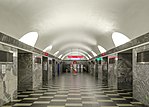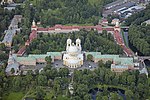Tauride Palace
1789 establishments in the Russian EmpireGovernment buildings in RussiaGovernment buildings with domesHouses completed in 1789Legislative buildings in Europe ... and 7 more
Neoclassical architecture in RussiaNeoclassical palacesPalaces in Saint PetersburgPalladian architectureRoyal residences in RussiaRussian Provisional GovernmentSeats of national legislatures

Tauride Palace (Russian: Таврический дворец, romanized: Tavrichesky dvorets) is one of the largest and most historically important palaces in Saint Petersburg, Russia.
Excerpt from the Wikipedia article Tauride Palace (License: CC BY-SA 3.0, Authors, Images).Tauride Palace
Shpalernaya Street, Saint Petersburg Peski (округ Смольнинское)
Geographical coordinates (GPS) Address External links Nearby Places Show on map
Geographical coordinates (GPS)
| Latitude | Longitude |
|---|---|
| N 59.947777777778 ° | E 30.375833333333 ° |
Address
Таврический дворец
Shpalernaya Street 47
193060 Saint Petersburg, Peski (округ Смольнинское)
Saint Petersburg, Russia
Open on Google Maps











